
This morning, we were not woken by the familiar rounds of a boatman announcing first-call for coffee. We were sprung out of sleep by a shriek rendered by Ellen, who was having a close encounter with wildlife. A visitor had found its way into her tent and subsequently crawled atop her while she slept. From the fear in that piercing scream, you would have been certain that a mountain lion, rattlesnake, or scorpion was keeping her company – not a little old mouse.
Exiting camp is ever more expeditious as the routine becomes a habit and we master the art of speed packing. We deliver our dry bags at lightning speed to the rafts before a quick breakfast and the preparation of another sack lunch prior to our departure. Into the rapids we go; the first is the namesake of our camp, Olo, which means horse in the Havasupai language. The next rapid would require fixing the helmets to our noggins – Upset Rapid. Both were run with the efficiency and skills we have become accustomed to, not to imply this whitewater business is being taken for granted. The boatmen have not stopped reminding us of our role in maintaining safety and the danger that is never far from snatching one or all of us from a dory should we stop paying attention to the river and the instructions of our boatman.
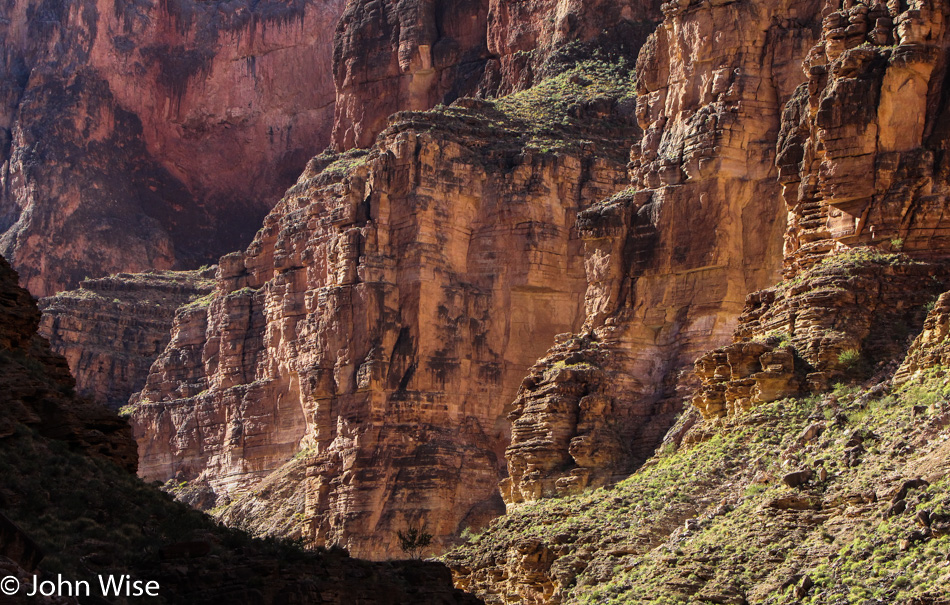
The Canyon walls are close to the river today, the shadows especially dark. Our time on the water this morning is brief, although we travel 11 miles before our first stop. Along the way, we pass over more of these intriguing river phenomena known as boils. This is appropriately named as that’s just what the river looks like it’s doing: boiling. Below the surface, the uneven terrain of the riverbed or a rock pile alters the flow of water. The blockage allows some of the water to flow downstream over the obstacle while another part is redirected back upstream. Between these two flows, the rest of the water is pushed straight up, creating the appearance of a boiling cauldron.
Briefly, a glimmer of sunlight finds its way into the labyrinth, but before we know it, we are rowing back into deeper shadows, walled in by stone monoliths. Remember, these are not just any old rocks; these are far from boring. Here in the Canyon, it would be foolish not to look closer, even stare, at the rocks. These are the reflections of our history. This is where you are allowed to have your very own peek at prehistoric Earth. If you are interested in Earth’s story, take time prior to your excursion into the Southwest and “bone up” on the mineral and fossil history to be found here. Get excited before starting out on your own journey into a better understanding of our paleontological roots.

Above the river on the cliffside, there appear to be the remains of a cave, but upon closer inspection, it looks like fragments of travertine. Now smashed to bits by rockfalls of cleaving stone and heavily eroded over the centuries, the limestone formations beg for interpretation. The jumble of broken shapes and varied colors appear to have been stalactites, but that will be the most I can decipher as we float by.

When the river is calm, and a burst of direct sunlight falls on the steep cliff-sides buffeting our course, the mirrored riverway ahead of us shines brightly. On the surface of the Colorado, the horizon begins to blur. I scan the river, looking for that perfect window into the opposite view of what is sitting above the waterline. The reflecting glow of the Canyon, topped and bottomed with deep blue sky, asks us to stop, take a deep breath, and savor these moments.
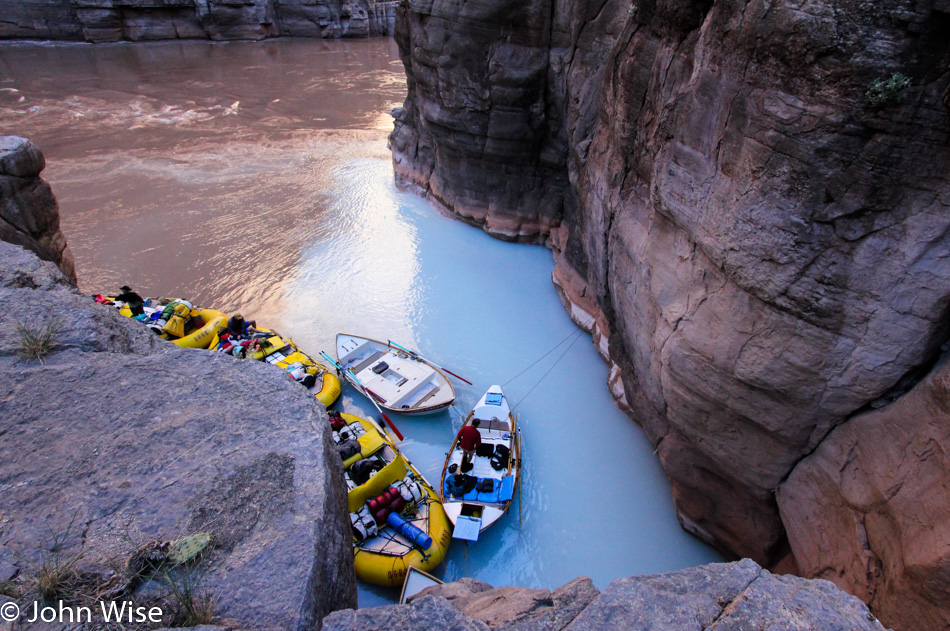
Pulling around the next bend in the river, we are about to witness another iconic location. Our first glimpse of the milky turquoise waters of Havasu Canyon comes into focus. They are flowing out of Havasu Canyon to mix with the sediment-rich Colorado. Back on our first day at Lees Ferry, the river ran clear due to the settling of the sequestered Colorado languishing behind Glen Canyon Dam. Over time, the fine sediments that were collected while carving the landscape north of the dammed river find their way to the bottom of Lake Powell, and what is released from the dam is cold green water. As the river continues its journey, many side channels contribute their streams with their own accumulated sediments to the river that continues scouring the main channel. This big river we travel on is laden with the iron-rich ocher-hued sands for which it was named. With the flow of the Colorado having doubled in the last days, there is even more turbulence in the water, agitating the silty bottom and suspending a fine particulate soup that turns the river into a muddy liquid knife, slicing an ever-deepening path through the Canyon.
Just before entering Havasu Canyon, the boatmen work hard to avoid the pull of whitewater that is Havasu Rapid, delivering us to a rocky shelf on river left. They row the empty dories upstream into the narrow canyon mouth. The tie-up is up against the wall of Muav Limestone. The boats are now parked in what looks like a pool of bluish milk. This image is almost as famous as the waterfalls further up Havasu Creek on the Havasupai Indian Reservation. One of the boatmen takes the lead up the streamside trail, and we are soon on our way to discover another of the many famous side canyons.

Our hopes of finding this golden opportunity to visit Mooney Falls, near the capital town of Supai, were dashed, as the rare commodity of time was not ticking in our favor. As early as the day started, and as fast as the boatmen rowed, we would be hard-pressed to visit a fraction of Havasu Canyon, let alone hike the 7 miles to Mooney Falls and back. Maybe summer visits with 16 hours of daylight could offer enough time for river runners to hike in and out, but then again, they’ll be jogging an often precarious trail in 110 degrees of withering heat. We, on the other hand, will have to make camp today before night descends around 6:00 pm.
The hike into Havasu is on limestone stained red from the iron in the rock layers above. We walk over narrow ledges next to soaring cliffs while the sunshine falls on the opposite side of the creek, with little of its warmth bouncing over to our side. Mind you, it’s not cold, just a wee bit chilly in the shadows – and although it is November, I am still comfortable in shorts and a thin shirt. On our scramble to a suitable picnic location that, at a minimum, should be supplying a perfect view with an impressive backdrop, we will be passing through the creek a couple of times.
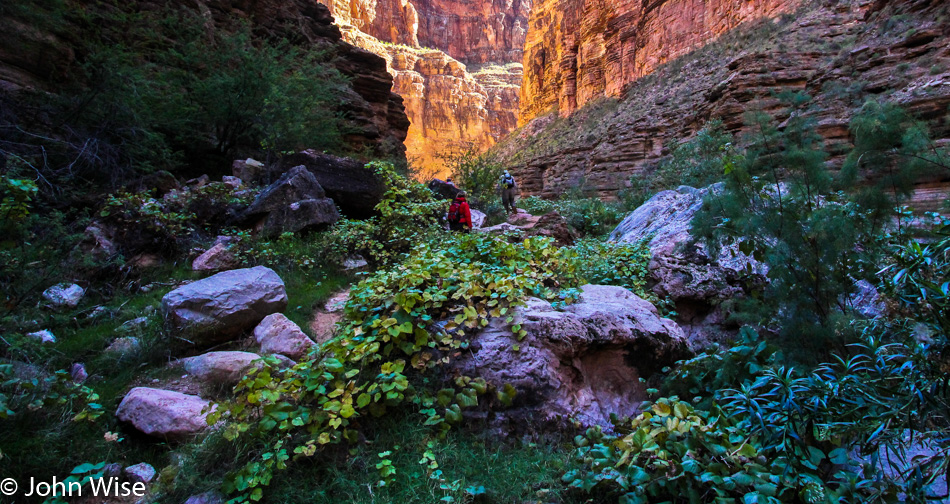

The water feels awkward to step into, probably due to its peculiar bluish-chalky color. The spring that feeds the creek is mineral-rich and loaded with calcium carbonate, the stuff of travertine and cave formations. While it is less than knee-deep, we cannot see much more than an inch past its surface and must be especially careful where we place our next step. The creek is also much warmer than the Colorado we left behind. We carefully wade across, facing upstream to avoid slipping in the current flowing over the slick rocks.
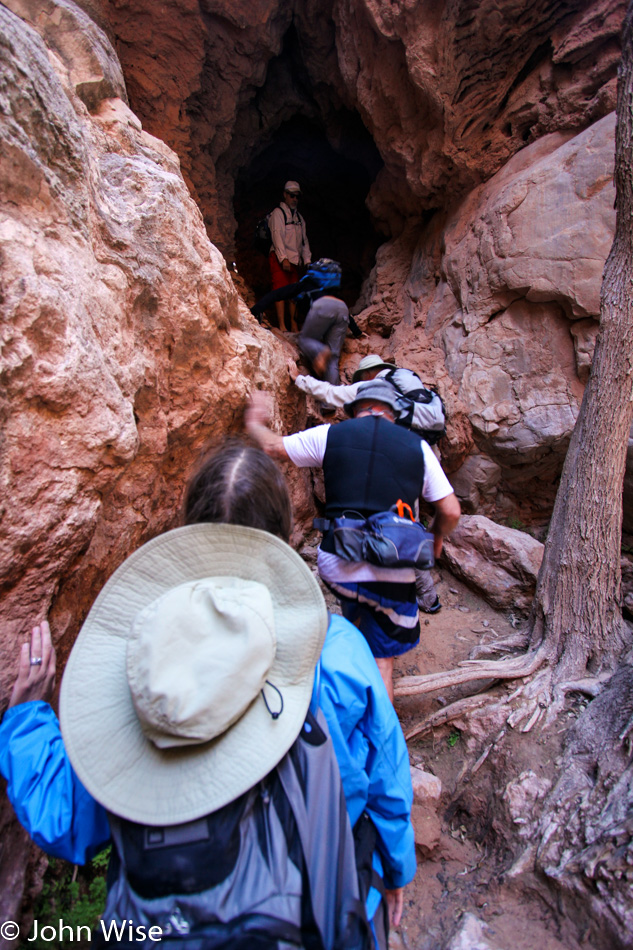
After a final crossing, we must pass through a tunnel camouflaged as a cave. We scramble through and emerge into a whole new world. The canyon widens, and the sun is within our reach. It will be here that our hike into Havasu Canyon comes to an end. We pause for lunch and enjoy some time to warm our bones and absorb the beauty of the creek. Caroline and I sit on a rock, dip our feet in the water, and enjoy our meal.
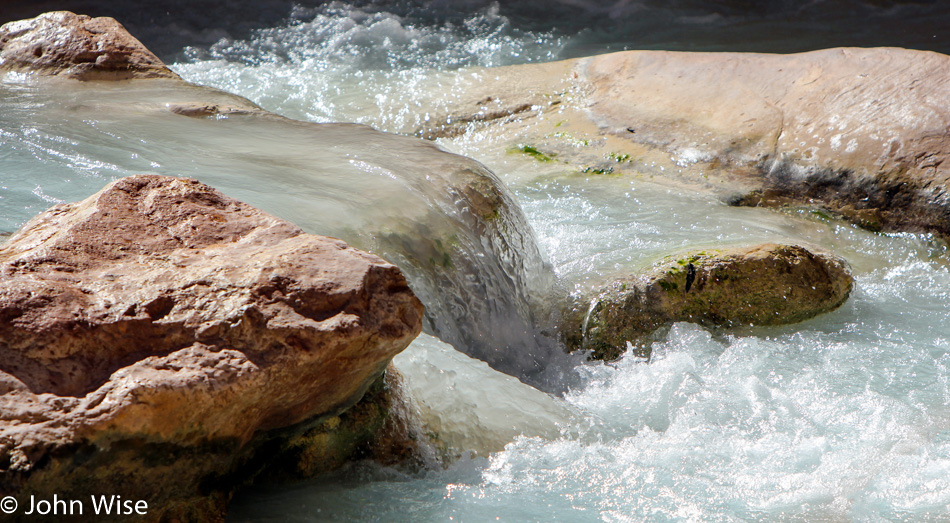
This end of the canyon is but a small part of the ancestral lands of the Havasupai tribe. Havasupai means “Blue Water People.” For more than 800 years this canyon and the surrounding area have been their lands. Near extinction just 100 years ago, today, the tribe is still small, with fewer than 650 members. Tourism into their corner of the Canyon now sustains them, while visitors enjoy the strenuous hike to the famous Havasu Falls further up the canyon.
How do our boatmen see their relationship with these canyons? As I lament the brevity of my time to linger in each location and scheme how I will bring as much as possible from this one exposure back home with me, I wonder if this desire to absorb it all can ever be satisfied. While the boatmen will likely return again and again, they also must know that each of the subsequent visits will only be for brief moments. Neither can they be full-time residents here in this corner of the world they are obviously hopelessly attached to. This desire for eternal memories must in some way explain their lasting relationship with running the mighty Colorado. Why else would so many river runners commit to returning season after season? Running the Colorado is not a path to fortunes unless you consider what your heart and mind are rewarded with. Maybe the real wealth comes from the idea and hopes that something so big might someday be truly known or at least better understood.

Could it be that the real magic to be found in this vast National Park is not to be gleaned from the infinite details or the magnitude of beauty but from how this place channels our inner vision to a focus that allows us to look deeper within ourselves? Maybe the time away from the constant electronic noise and our routine, time-consuming activities offers the mind a quiet opportunity to resolve our own conflicts or bring insight into things we might have been unaware of prior to setting foot into the Canyon. For those who might bring their cellphones or iPods down here to play games during the “boring” parts, I wonder how unfamiliar these folks are with the machinations of their own minds. How did they come to perceive nature and their relationship to it as possibly being enhanced through the display of a small electronic screen that entertains them with tiny little pixels?

The two hours slated for today’s visit to Havasu Canyon soon come to an end. I try to convince myself that what I have taken in was enough, but I’m left wanting more. Not having the chance to visit the falls further upstream, Caroline and I vow to dedicate a future visit to a hike down to Supai village, spending a couple of days exploring more of Havasu Canyon. On that trip, we’ll be able to look back to this lucky day when our eyes first caught sight of the luminous, chalky waters that run through here and how we stepped off the dories from the Colorado River to visit the bottom of Havasu Canyon.
While probably displaying a good amount of obsession, it should also be obvious that I am trying to gather as much from this experience as I can. I look forward to sharing and celebrating the rarity of being one of the few humans who will see what I have seen down here. I tease apart every observable angle to lend more gravity to the weight of these memories. My day job here is to memorize the floor plan with a detailed inventory of all that is extraordinary. During the night shift, my sleep continues to explore the uniqueness of this experience. Although my dreams might prove elusive and forgotten to my conscious mind, I can hope that the sights and sounds of each day, the stories heard, and all of these fully lived moments will work together to paint a riot of beauty in the imagination of my resting brain.

Cynicism finally raises its ugly head, asking me: what remains to be seen? Havasu is left behind. Does any more of the extraordinary exist between us and Lava Falls? And then, what comes after that? Is river life going to turn into a routine where expectations of the familiar kill my anticipation of the wonderful? If this moment were a seed sprouting to grow this line of thinking, I could be setting myself up for boredom as I await the grand exit. Just how many iterations of spectacular and beautiful can be had? At some point, we must run into a broad expanse of dull. We’ll row into the doldrums of a wide, flat river with a dreary desert eating the horizon, diminishing our ability to spot the incredible. My anxiety tells me that it’s probably here, right after Havasu Rapid, up around the corner – the forbidden zone. From there, we will suffer the long, slow approach to the punisher known as Lava Falls, which is laying in wait to stomp us into submission before spitting us over to Diamond Creek. There, the rescue team will try and revive our exhausted spirit before we face the return to what was once known as normal.

Nightmares, the folly of our fears. Fortunately for me, I am quickly woken from these fiendish traumas of the imagination. My reawakening occurs on the other side of the river bend. The light here is doing that Grand Canyon thing, where high golden cliffs dip reflections into the river ahead, bringing on a state of visual bliss. We are entering the mirror, passing to the other side where our fairy tale continues. A minute ago, a negative voice rose from dormancy to cast doubt on my ability to see that great brilliance is always just around the corner. How do I sear the lesson of optimism into my memory?

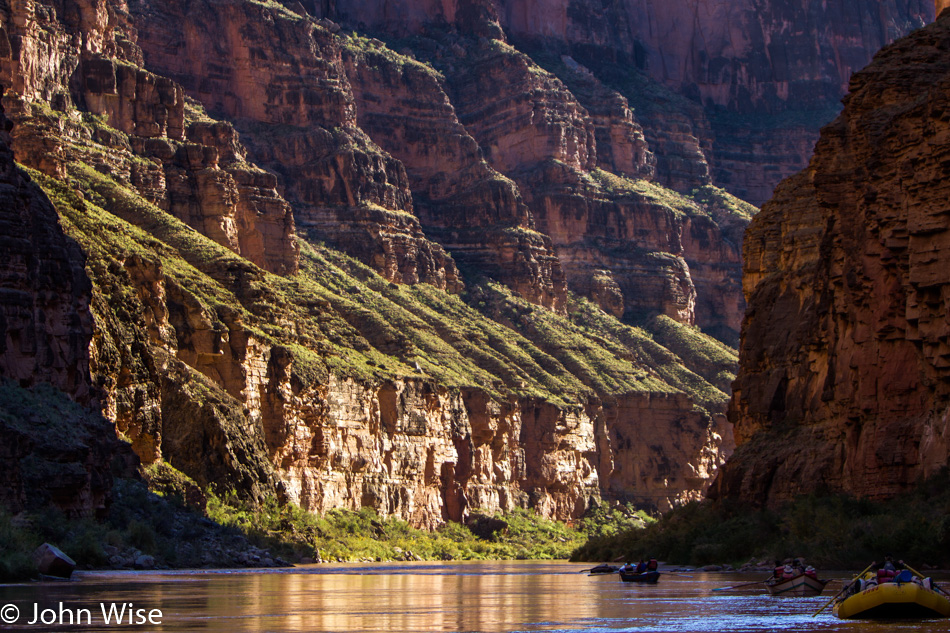
Our next mile sees the sun moving lower, ratcheting up the shades of gold, and delivering even greater wealth without so much as a wish. Days ago, back at Redwall Cavern, I wondered about the boatmen’s impeccable sense of timing; here we are again approaching one of those junctures. As the Earth spins us toward evening, we are passing through the late afternoon on a stretch of river with sparkling sunbeams leaping off whitecaps that rise out of a shimmering black highway to another world. Just as quickly as the glimmers spring into my eyes, they are equally fast to subside, extinguished with their fall back into the Colorado. As the river works to steal the sun, it also absorbs any ambient noise, aside from the slip of the oar. I am left with the idea that I am floating in space with a billion shining stars pulling me further into the universe. The oars are the propulsion system for our spaceship. Legends arise out of these moments; mythologies gain epic scope from this display of imagery, transporting us across space and time into the infinite.
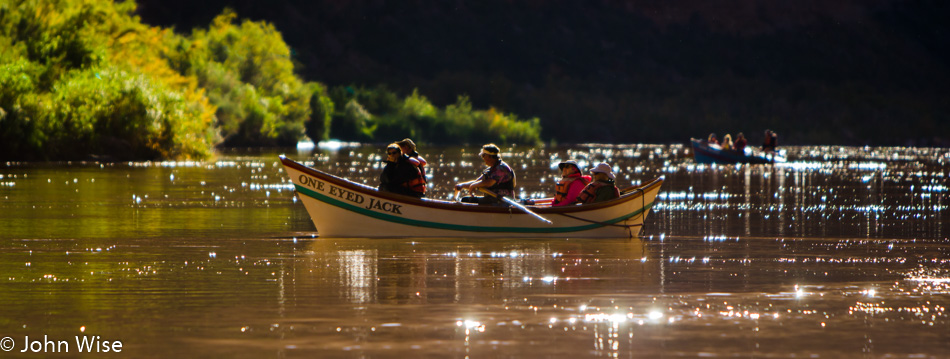
Up to this point in the story, I have shared one of the difficulties facing me on this trip: my fear of heights. There is one other issue that nearly stood in the way of being able to make it this far – I have sleep apnea. Sleep apnea is a condition that stops me from breathing while I sleep until I briefly wake and gasp violently for air. These episodes are particularly bad in my case, lasting for 19 seconds on average. My wife had complained about my snoring for years, often telling me of my struggle to breathe during the night. Since I did not believe her, she recorded me and then frightened me with what I heard. A doctor’s appointment and a sleep study later, I was set up with a CPAP device and have been well-rested ever since. Sleep apnea need not be a huge problem; it is easily treatable – as long as one has access to electricity, which I do when at home or in hotels. However, these dories do not travel with generators, there are no riverside outlets, no opportunity to recharge batteries, and during the short days of fall, not enough sunshine to effectively use solar panels. Add to this that we plow through rapids daily, where solar panels would exit the boat lickety-split or at least be destroyed by the water crashing over the bow. Yet I needed a solution that would power my CPAP and enable me to sleep soundly for at least a majority of the 17 nights we would be in the Canyon.
For months, I was not able to find useful information beyond hunters using their truck batteries for a couple of nights or folks in storm-prone Florida who had tried various one- or two-day options during occasions when the electricity was knocked out by a passing hurricane. As the weeks went by and it grew closer to the date when we could still cancel with the hope of seeing some refund of our investment, I was getting nervous. I even read of someone who dragged two 40-pound deep cycle marine batteries on a raft for his Grand Canyon trip. Prior to his departure, he had also arranged to have two fully charged replacement batteries delivered by mule to Phantom Ranch, the halfway point, with the two depleted batteries to be carried out using the same expensive four-legged method.
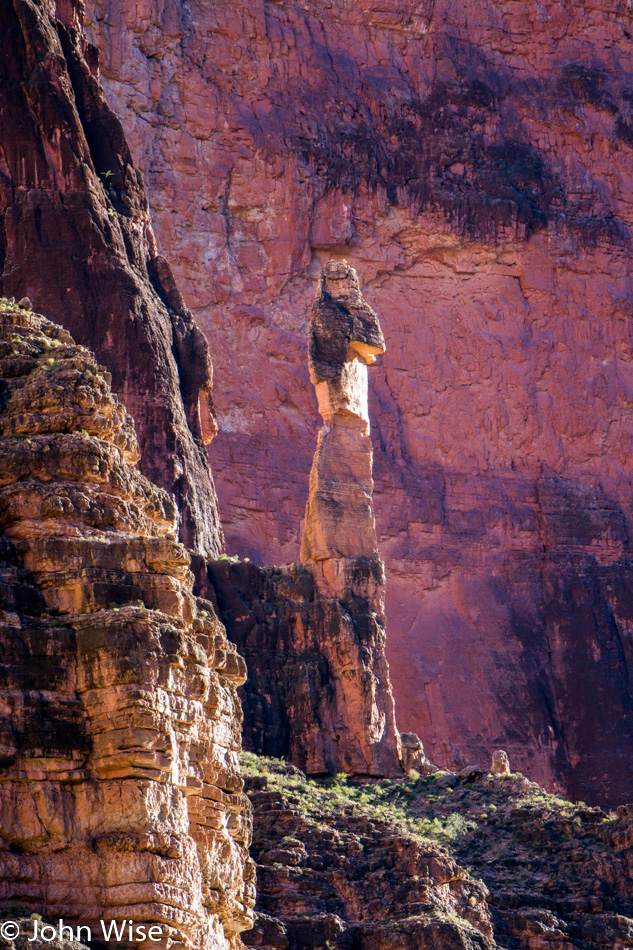
It was looking as if people with sleep apnea had given up on exotic adventures that required them to go off-grid for any period of time. Then, just a couple of weeks before we would have to cancel, I spoke with Chris, the owner of TheCpapShop.com. He thought he might have an answer in the form of a nine-pound 10”x7”x3” battery. What he didn’t have was concrete information on how others had fared with this compact and relatively lightweight potential solution. He had sold this type of battery before to travelers going off the grid, once to someone who was taking an African safari and another time to someone who was trekking the Himalayas – unfortunately, they never got back to him regarding the battery’s performance. Chris was willing to work with me to determine the best solution that could meet my needs, so I ordered a test unit.
After four weeks of keeping meticulous records of the number of hours and minutes that I used the battery, I calculated that I would need to bring two of these units with me into the Canyon. A few days later, I received the second battery. I packed both into a waterproof, crushproof Pelican case with room left over for the CPAP unit, almost a dozen batteries for my camera, batteries for my GoPro waterproof video camera, and my wife’s waterproof camera. I also found space for batteries for our GPS, headlamps, and a small tent lantern. Oh yeah, and my writing materials and my 70-200mm zoom lens, although it didn’t stay in there long. The entire setup weighed in at 38 pounds – two pounds lighter than one marine battery, and no need to employ the pricey mules.
The batteries were to supply my CPAP with a hair more than 40 hours each. This would give me five hours per night of restful sleep, leaving me with one night to rattle my fellow campers with bombastic snoring. I thought I could live with this, and I did. For my efforts, I was able to offer sound advice regarding a lightweight remedy to a problem more and more people are starting to deal with while making this trip that much more enjoyable for my wife and me. The generosity offered by Chris helped me put together a solution that would bring us to new adventures in locations where electricity is not to be found and where bulk and weight limitations have to be taken into consideration.
So, if you should find yourself wanting to experience the trip of a lifetime, but an ailment is giving you pause, I suggest you dig deep into resolve and find a solution and way to live your dreams regardless. Talk to outfitters to determine if they have a record of other clients who had to deal with an issue similar to your own; search the internet and find what it will take to overcome personal challenges that might be inhibiting you from full participation in the adventure of life. However, one defines adventure.
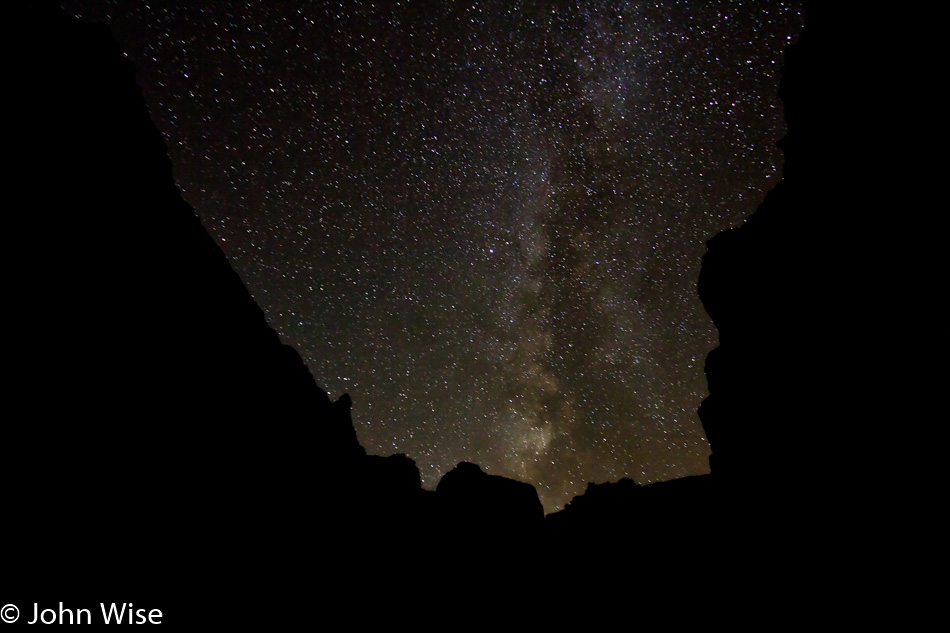
This brings me to another story of overcoming adversity, and it stems from the efforts made by one of our boatmen, Jeffe Aronson. Jeffe founded an operation known as Jumping Mouse Camp, where he and many other volunteers, including Joe Biner, brought people with special needs, and in some instances life-threatening illnesses, into the world of whitewater adventure. For some of these lucky adventurers, it may have been the single greatest opportunity to connect with nature. For others, it was the chance to better understand their own place in the scheme of things and find a kind of peace with their situation. These journeys of the heart enabled the participants to share the tears of accomplishment in a world not known for sharing the emotions of personal challenges. These specially crafted, laborious life trips were not to last – the program ultimately came to a halt. For those lucky enough to have participated they gathered the strength and manifested the necessary gumption to board a raft, be shot over the whitewater, and explore the Grand Canyon. As they survived Lava Falls, Crystal, and the inner Canyon, they were also busy surviving life. I am certain the memories of this epic mouse tale live on in their hearts.
My sleep apnea was an easy obstacle to overcome; the inner strength of a person locked into a wheelchair without the use of their own arms or legs to take such an adventure is an act of courage that should be an inspiration to all of us. It was Bruce who read us the story of Jumping Mouse from the book There’s This River…Grand Canyon Boatman Stories. Caroline and I had read this story in the months prior to our departure and promptly forgot the names of many of the characters until now. We had not realized that it was this very boatman named Jeffe who was so instrumental in forging these legendary experiences – now a hero in our eyes.
–From my book titled: Stay In The Magic – A Voyage Into The Beauty Of The Grand Canyon about our journey down the Colorado back in late 2010.